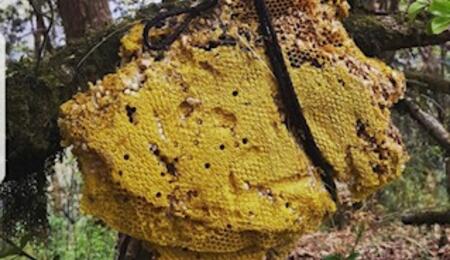The Nepalese mountain honey that can get you high...

As plants go, Cannabis is pretty unique. It seems like every day, we are learning more about its excellent benefits. There are, however, other examples of plants like Cannabis. Plants with their own mind-blowing natural effects that are still shrouded in mystery and go relatively unheard of.
There's a rare type of honey originating in Nepal that can get you high. What makes it sound even more like the stuff of legend is how hard it is to get hold of. It is made by Himalayan honey bees at only a specific time of the year in nests far from anybody's reach. Nepalese villagers from the Gurung tribe have used it for generations, often embarking on long and perilous treks to collect it from the wilds of the Himalayan mountains.
Honey has been eaten for thousands of years and is proven to have benefits for human health. This honey is different, however. It is both a hallucinogenic and a poison. "Mad Honey", as it is known, is believed to be potent natural medicine. If taken in small doses, it produces mild highs. In larger quantities, ingesting the honey can send you on a toxic, cold-sweat trip of hallucinations, vomiting, and diarrhoea that can last for more than 24 hours or even kill you!
Nepalese villagers believe that eating one teaspoon at least once a year develops the immune system. They also use it to cure diabetes and hypertension, treat aches and pains caused by arthritis, and improve sexual performance. However, the most common use for mad honey is a mild painkiller to dull the aches of farm work and alter their moods slightly, just like that spliff you have when you get home from work.
It's not just native tribes and rural villagers that are using "mad Honey", however. Word is spreading, and Recently, a large market for nectar has opened up throughout northeastern Asia. Big buyers from China, Japan, South Korea, and North Korea have shown an interest in the potential of mad honey as an erectile function treatment.
Mad honey is runnier than regular honey and dark, reddish in colour. This originates from grayanotoxin, which is contained in the nectar of a particular species of Rhododendron. The flower in question is rare and only found in Southern Turkey, Caucasus, Nepal, and Japan.
Grayanotoxins are a group of neurotoxins. Grayanotoxins are a product of plants belonging to the Ericaceae family, including the Rhododendrons. There are more than 700 types of Rhododendron, but only two or three include grayanotoxin in their nectars."
Grayanotoxin can be found in all plant parts, including flowers, leaves, stem, nectar and pollen. This explains why traces of the neurotoxin are present in a wide variety of secondary plant products such as honey, herbal medicines and cigarettes.
The psychedelic effects of "mad honey" have been likened to a typical weed stone and mushrooms. Inducing a feeling of relaxation, pleasant dizziness, and tingling sensation. The cerebral effects of mad honey were known in ancient times, and it was even used as a chemical weapon. In 401 BC, Greek soldiers travelling through modern-day Turkey near the Black Sea indulged in similar honey and were debilitated with intoxication.








